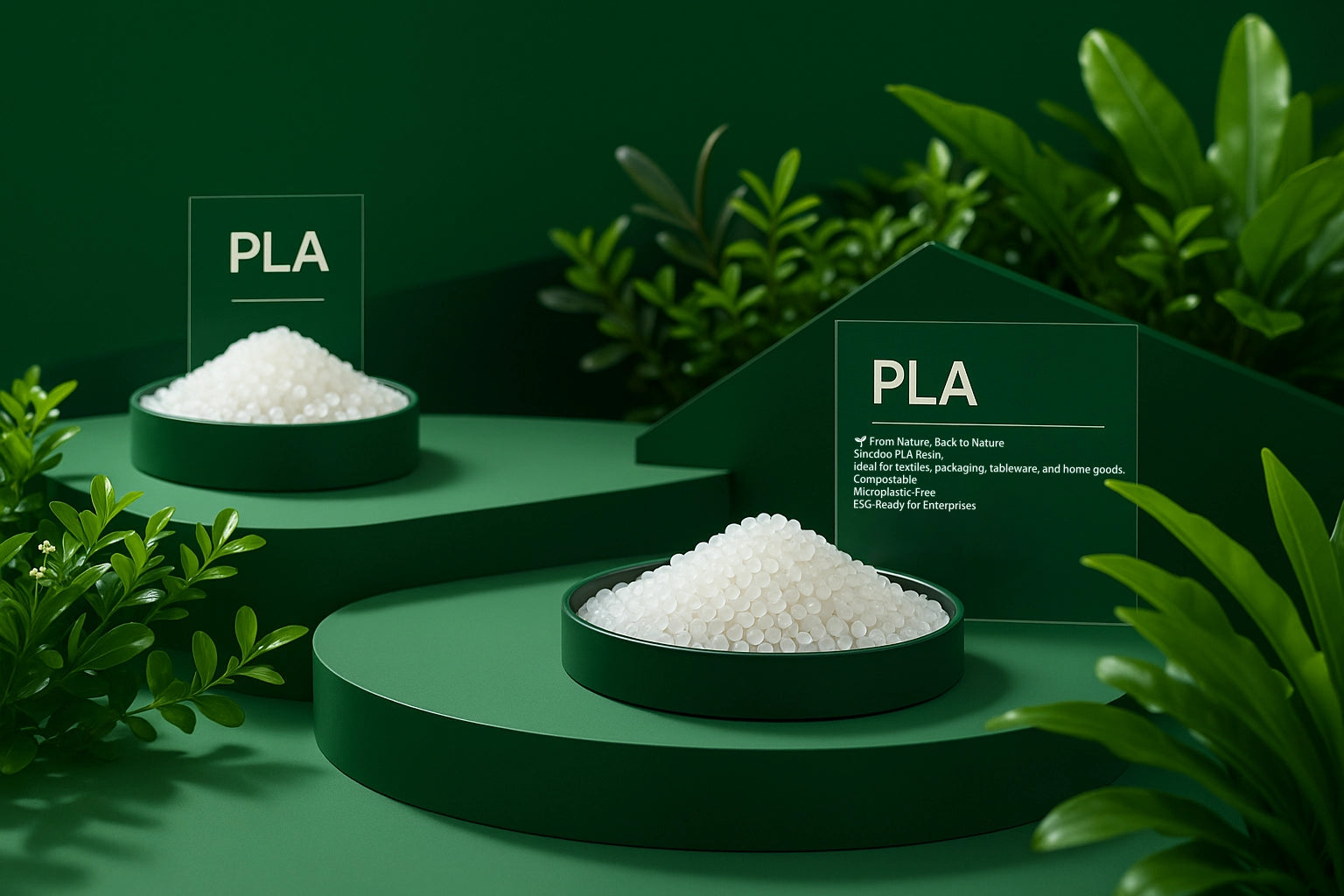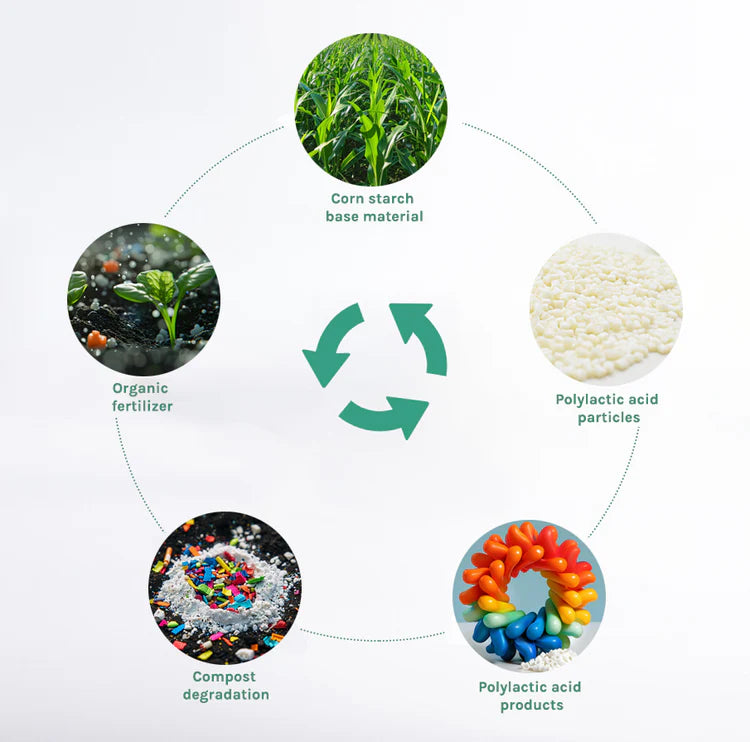
About Sincdoo PLA
PLA bioplastics represent a forward leap in developing greener, more sustainable materials for a healthier planet.
PLA offers an effective material solution for reducing environmental pollution and advancing sustainable development through its environmental friendliness, renewable sources, and application versatility.
Sincdoo Biotech Co., Ltd. is a subsidiary of the ZB Group, specializing in the research and application of polylactic acid (PLA) products. ZB Group is a large apparel manufacturing company in China, providing OEM services to numerous well-known brands in various fields, including suits, sportswear, casual wear, outerwear, coats, underwear, children’s clothing, and home textiles. In addition, ZB Group also develops specialty fabrics for specific applications.
As a subsidiary of ZB Group, Sincdoo is committed to the development and application of sustainable, biodegradable products. Leveraging ZB Group’s strong design and supply capabilities, we offer innovative solutions and high-quality products in the fields of PLA fibers for clothing, PLA daily products, and PLA medical supplies.
Raw Material Procurement:
While most biodegradable materials on the market are derived from staple crops, Sincdoo is dedicated to selecting higher-quality, more responsible raw materials for PLA. We prioritize the procurement of raw materials that have minimal impact on food supply, such as straw, sugarcane, and a small amount of genetically modified corn, which are used for fermentation to produce PLA. These materials are often agricultural by-products or high-yield crops that do not significantly affect global food supplies. Additionally, the by-products of fermentation can be used for the production of other products.
This raw material procurement strategy not only reduces competition for food resources but also adheres to sustainable development principles, promoting environmental protection and resource efficiency. Sincdoo hopes to contribute to global food security and ecological balance while promoting PLA products.
Technological Innovation and R&D Capabilities:
PLA modified Granular Products: We collaborate with internationally renowned PLA resin companies, such as NatureWorks, Total Energies, Haizheng Bio, and Fengyuan, to customize modified PLA raw materials for different applications based on specific product characteristics.
PLA Fiber: We offer both short fibers and long fibers made from PLA. Through upgrades in production lines and improvements in weaving techniques, we produce high-quality, versatile fabrics. We provide 100% PLA fabrics, and based on customer requirements, we also offer blended fabrics to suit different usage environments, helping more enterprises achieve carbon reduction goals. For example, we replace polyester fibers with PLA fibers, greatly reducing the use of petroleum-based products. Our PLA and wool blended fabric ensures stable performance while avoiding the use of cotton and petroleum-based materials, as well as reducing the amount of wool used, ultimately improving animal welfare and environmental protection. In addition, Sincdoo offers blended fabrics made from organic cotton and RWS-certified wool to meet customer demands in various regions. We support customers with OEM solutions to produce PLA fabrics and finished clothing products.
PLA Daily Products: We provide customized PLA products, including daily necessities (knife,fork,spoon,cups, etc.)and 3D printing materials, and can add coffee grounds or rice husks to create unique appearances and enhance the environmental effects.
PLA Medical Field: We offer disposable PLA products for hospitals, such as medical sheets and white coats.
Automotive and Building Materials: We also develop various eco-friendly products that incorporate PLA materials, aiming to minimize environmental pollution and help related enterprises reduce carbon emissions.
Sincdoo’s Certifications and Team
We provide various certifications, including DIN, TÜV, BPI, and others. Sincdoo has a professional R&D and design team, collaborating with well-known research institutions and universities to jointly develop high-quality products. Our designers come from globally recognized apparel companies and are capable of providing customized, high-quality product development solutions in partnership with customers.
Sincdoo PLA Recycling Solutions
Due to differences in regional policies, not all areas are equipped for biological composting and degradation. Therefore, we provide several PLA recycling solutions:
Composting: In areas with composting facilities, customers can directly compost and degrade PLA products.
Recycling and Reuse: We cooperate with recyclers in China to recycle PLA products, crush and extrude them into flooring materials used in interior and exterior decoration.
Incineration: In regions with electricity shortages, PLA products completely combust to produce water and carbon dioxide, significantly reducing environmental pollution compared to chemical products.
Enzymatic Degradation: Sincdoo has partnered with XIKE Enzyme to develop enzyme preparations that accelerate the degradation of PLA, aiming to further demonstrate PLA’s advantages in the biodegradable field.
*Research has shown that PLA, even when decomposing slowly in the natural environment, will not result in microplastic hazards.
https://www.businesswire.com/news/home/20240620796233/en/New-Meta-Study-Highlights-That-Hydrolysis-Prevents-the-Formation-of-Persistent-PLA-Microplastics-in-the-Environment
-
Environmental Friendliness
PLA is biodegradable, meaning it can decompose into water and carbon dioxide in industrial composting facilities, significantly reducing environmental impact. Compared to traditional petroleum-based plastics, the production and decomposition of PLA emit fewer greenhouse gases, contributing to mitigating climate change effects. Moreover, PLA's degradation process does not produce harmful microplastics, crucial for protecting aquatic and soil environments.
-
Renewable Sources
PLA is derived from corn starch, sugarcane, and other crops, all renewable resources. This starkly contrasts with traditional plastics produced from finite fossil fuel resources. Utilizing renewable resources not only helps reduce dependence on fossil fuels but also promotes sustainable agriculture, creating new value for agricultural by-products.
-
Versatility of Application
PLA's excellent physical and chemical properties have led to its wide application across various fields, including packaging materials, disposable tableware, textiles, medical supplies, and 3D printing materials. This versatility makes PLA a highly flexible material that meets different industries' demands for eco-friendly materials. The diverse applications of PLA demonstrate its significant potential in promoting environmental sustainability and supporting the growth of a green economy.


The Sustainable Lifecycle of Polylactic Acid (PLA)
Polylactic Acid (PLA) is a groundbreaking sustainable material that demonstrates a complete circular lifecycle. Derived from renewable resources such as straw, corn starch, and sugarcane, PLA is processed into versatile products that, after use, naturally degrade through composting into organic fertilizer, water, and carbon dioxide. This eco-friendly cycle reduces waste, protects the environment, and contributes to a greener and more sustainable future.
Common Questions About Polylactic Acid (PLA)
Why is PLA considered environmentally friendly?
PLA is deemed environmentally friendly because it is derived from renewable resources like corn starch or sugarcane, which absorb CO2 during their growth, reducing greenhouse gas emissions. Moreover, PLA can fully biodegrade under proper conditions, diminishing long-term environmental pollution.
If PLA is inadvertently discarded in the environment, what is its impact on health and the environment?
Compared to traditional plastics, PLA, due to its biodegradable nature, will not persist in the environment and generate microplastics, thereby lowering potential harm to both the environment and human health.
How is PLA's biodegradability achieved?
PLA's biodegradability is achieved through the breaking of specific molecular chains under the high temperature and humidity conditions of industrial composting environments, eventually decomposing into carbon dioxide and water. This requires specific composting facilities.
What are the advantages of PLA in applications?
PLA's application advantages lie in its versatility and customizability. It can be used to manufacture packaging materials, disposable tableware, clothing products, durable goods, biomedical products, and even automotive interior products. It can also be modified by adding different additives to enhance its heat resistance or alter its biodegradation rate, meeting the needs of various fields.
How is PLA different from other bioplastics?
Compared to other bioplastics, PLA typically shows better performance in biodegradability, source material, and the environmental impact of its production process. PLA's raw materials are primarily agricultural crops, giving it a clear advantage in reducing dependence on fossil fuels.
Compared to traditional plastics, what are the safety and health advantages of using Polylactic Acid (PLA) products?
PLA products offer several significant advantages in terms of safety and health, especially when used for food packaging and containers and infant products:
1- No Harmful Substance Release: Made from natural renewable resources, PLA does not contain harmful Bisphenol A (BPA) or other chemicals that could negatively impact human health. In contrast, some traditional plastics may release harmful substances when in contact with food or exposed to heat.
2- Biocompatibility: Due to its bio-based nature, PLA is more body-friendly and widely used in the medical field, such as biodegradable sutures and drug delivery systems, indicating PLA is considered to have a lower toxicity risk to humans.
3- Reduced Chronic Exposure Risk**: Since PLA is biodegradable, using it reduces the accumulation of microplastics in the environment, thereby lessening people's indirect exposure to microplastics through the food chain. Long-term exposure to microplastics is believed to potentially have adverse health effects. Especially in baby toys, due to babies' chewing habits, it can prevent babies from ingesting plastics and causing harm to the body.
4- Safer Waste Disposal**: The biodegradable nature of PLA products means they can fully decompose under appropriate treatment conditions, reducing the risk of harmful chemicals being released into the environment during waste disposal processes.
Common questions about Polylactic Acid products.
Application scenarios for Sincdoo Polylactic Acid (PLA) fibers
Sincdoo Polylactic Acid (PLA) fiber, as an eco-friendly and health-conscious material, offers a broad spectrum of applications, extending beyond mere filling materials to encompass the textile and apparel industry. As a filler, PLA fibers serve as an ideal alternative to traditional synthetic fillers, enhancing product healthiness and sustainability, making them suitable for use in filling materials for baby toys, sofas, and more. In the realm of clothing, PLA fibers stand out due to their unique advantages such as skin-friendliness, antibacterial properties, environmental safety, non-toxicity, stain resistance, water resistance, lightness, and comfort. These characteristics not only meet modern consumers' demands for health-conscious and eco-friendly apparel but also drive the clothing industry towards a more sustainable development path.
Application scenarios and product advantages of Sincdoo's durable Polylactic Acid (PLA) products.
Tableware: Sincdoo's PLA tableware is not only eco-friendly and biodegradable but also boasts excellent heat resistance and strength, making it suitable for both disposable and reusable dining services. It can also be applied in the field of infant and toddler utensils, replacing most plastic products.
Children's Hard Toys: The non-toxic nature of PLA material makes it an ideal choice for manufacturing children's toys, ensuring safety while offering durability and strength to withstand daily wear and tear.
Cosmetic Packaging Boxes: In the cosmetic packaging domain, PLA not only provides an eco-friendly packaging solution but also enhances brand competitiveness through its excellent appearance and customizability, offering new possibilities for brand elevation.
3D Printing Materials: As a material for 3D printing, PLA is widely recognized and appreciated by hobbyists and professionals alike for its environmental friendliness, printer compatibility, aesthetics, mechanical properties, health safety, and cost-effectiveness.
Sincdoo's durable Polylactic Acid (PLA) products not only meet the market demand for eco-friendly, healthy, and high-quality materials but also provide robust support for businesses to explore new market opportunities and enhance brand value.
The application of Polylactic Acid in the medical supplies sector
The application of Polylactic Acid (PLA) in the medical supplies sector showcases its unique advantages as a biocompatible and biodegradable material, including: absorbable sutures, drug delivery systems, stents and implants, tissue engineering, 3D printed customized medical devices, masks, disposable medical pads, and more. The wide use of PLA in medical supplies is not only due to its biodegradability and biocompatibility but also because of its potential for customization, offering patients more personalized and effective treatment options. These applications demonstrate the significant role of PLA in promoting sustainable development and innovation within the medical field.
The application of Polylactic Acid (PLA) in automotive interior
The use of Polylactic Acid (PLA) in automotive interior accessories represents a significant step towards sustainable and eco-friendly automotive manufacturing. Our current range of PLA-based products includes durable floor mats designed for long-lasting protection, ergonomically designed headrests for enhanced comfort, and versatile mobile phone holders for added convenience. These products not only showcase the material's versatility and durability but also its commitment to reducing environmental impact in the automotive industry.
The recycling of Polylactic Acid (PLA)
- Industrial Composting: PLA is biodegradable but requires specific industrial composting facilities with high temperatures and appropriate humidity levels for effective decomposition. This method can completely break down PLA into water and carbon dioxide.
- Chemical Recycling: Through chemical recycling processes, PLA can be depolymerized into its original monomers or other useful chemicals, which can then be reused in new polymerization reactions to create new PLA products.
- Mechanical Recycling: Although not as common as with traditional plastics like PET, mechanical recycling can also be applied to PLA. This involves physically grinding PLA products into small particles, then cleaning, melting, and reprocessing them into new products.
- Energy Recovery: Since PLA is made from organic materials, it can be incinerated to recover energy. While not the most environmentally friendly method of recycling, it can convert PLA into energy rather than landfilling in the absence of other recycling options.
